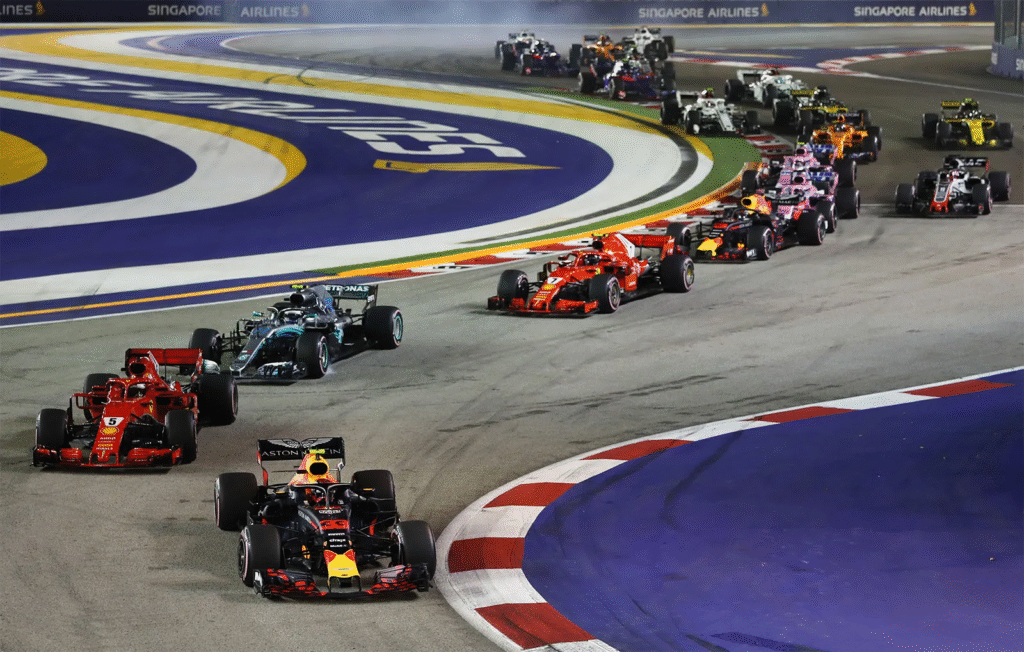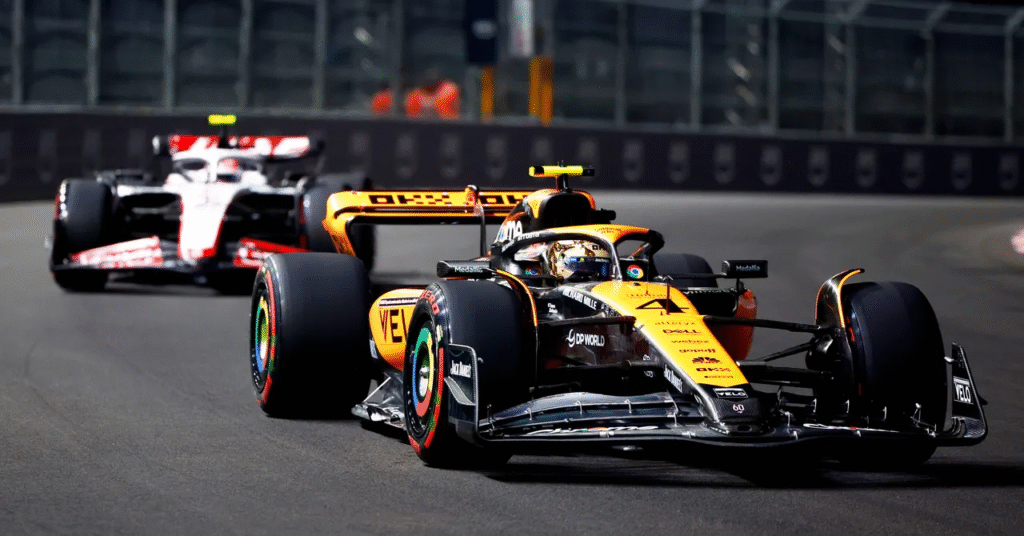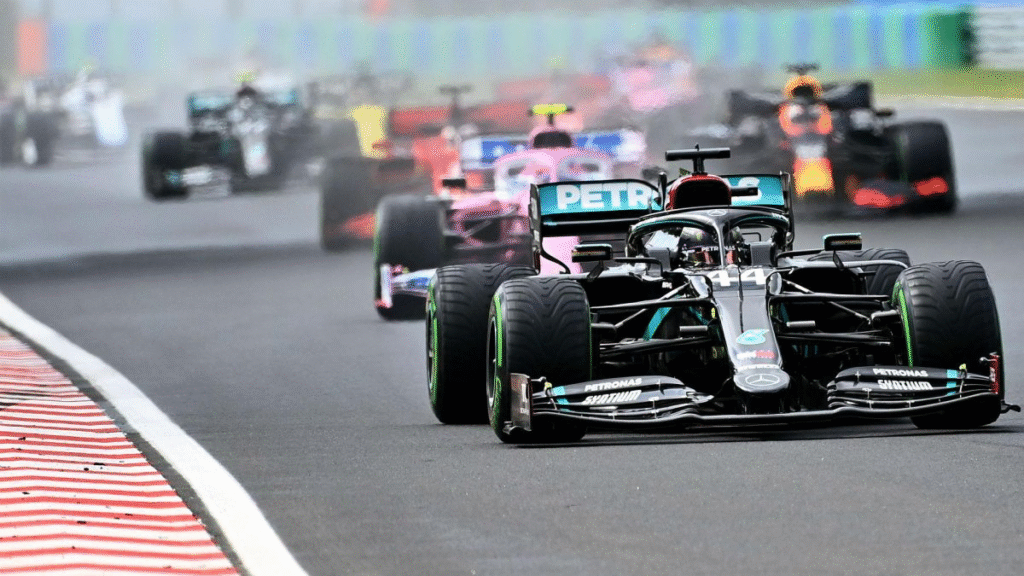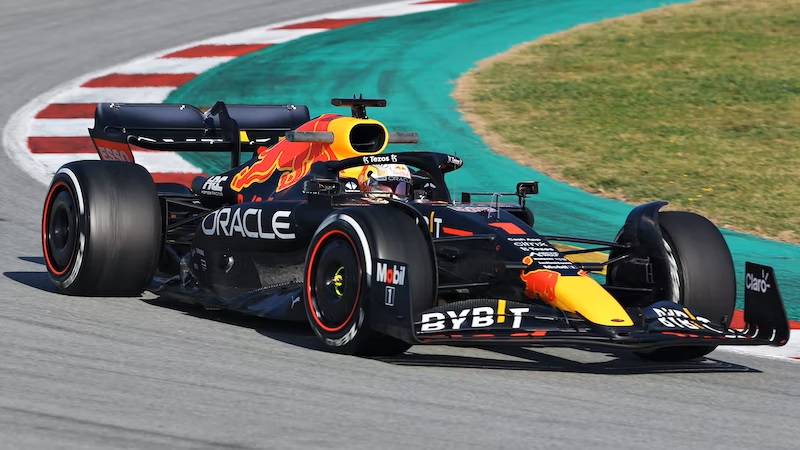Introduction of F1 Fitness and How It Differs from Other Sports
Most people’s initial impression of Formula 1 is of svelte vehicles travelling over 300 km per hour down a course. Although the technology in these vehicles is amazing in and of itself, the driver’s F1 fitness is another factor that is equally significant yet frequently disregarded. Although many people believe that driving a car—even an F1 car—requires little physical exertion, this couldn’t be further from the reality. In actuality, Formula 1 is among the most psychologically and physically taxing sports in the world, and the idea of F1 fitness is very different from what most athletes encounter in more conventional sports.
An F1 driver experiences harsh conditions in the cockpit that strain the human body to its breaking point. Drivers must endure temperatures inside their cars that can reach 50°C or more for almost two hours straight. They encounter up to 6 Gs of force when cornering and braking during the race. For comparison, fighter pilots encounter comparable G-forces while doing combat manoeuvres, but not continuously for two hours while making snap judgements at speeds of more than 300 km/h. Because of this, F1 fitness is crucial for both survival and optimal performance.
The combination of mental acuity and physical stamina needed for Formula One is another important characteristic that distinguishes F1 fitness. An F1 driver requires both at the same time, even if a sprinter may have explosive strength and a marathon runner may sustain lengthy hours of effort. Throughout the race, they have to be extremely focused and keep their heart rate between 160 and 180 beats per minute. Additionally, they lose two to three kilogrammes of body weight per race as a result of perspiration, which is why energy management and hydration are essential elements of F1 fitness.
The physical demands of Formula 1 are distinct, as even experienced athletes like cyclists and runners acknowledge. Because of the extreme endurance needed to withstand race conditions, drivers like Lewis Hamilton frequently liken their training to that of triathletes. Because of the enormous G-forces involved, Max Verstappen, one of the F1 fitness drivers on the grid, also places a strong emphasis on neck and core conditioning. The fact is straightforward: even the most gifted driver cannot give their best performance if they are not in optimal F1 fitness.
This blog will examine F1 fitness in great detail, looking at all the factors that go into making an F1 driver one of the F1 fitness and world’s fittest athletes. The physical and mental preparation that powers Formula 1’s best drivers will be revealed in this guide, which covers everything from strength training and endurance exercises to nutrition, hydration, and mental conditioning.
Formula 1’s Physical Requirements: Why F1 Fitness Is Essential
Steering and sitting in a car may seem like simple tasks at first. However, operating a Formula One vehicle differs greatly from operating a normal vehicle. During a race, a driver is subjected to harsh forces. G-forces can make the driver’s head and helmet, which weigh roughly 7 kg combined, feel like 30 to 40 kg while braking heavily. The muscles in the neck are severely strained as a result. Similar to this, the body is forced sideways by forces up to five or six times its own weight when cornering at high speeds. Significant strength and stability are needed to keep the car under control in these circumstances.
Another level of difficulty is introduced by the cockpit itself. With the steering wheel near their chest and their legs extended front, drivers sit comfortably. It takes core stability and flexibility to keep this position for two hours while making little modifications because it is not natural for the human body. Furthermore, an F1 car’s steering mechanism does not employ traditional power steering. To manoeuvre the car, especially in tight turns and chicanes, drivers need to employ their raw upper-body strength.
And then there’s the heat problem. When engaging in high-intensity training, it can feel like sitting in a sauna due to the high engine temperatures and little airflow within the cockpit. The driver loses many litres of fluid due to constant perspiration during a race. If left untreated, this might result in muscle cramps and dehydration. In severe situations, dehydration can affect judgement and reaction time, two vital skills in a sport where split-second decisions can mean the difference between success and failure.
Lastly, the emotional and physical strains are equally severe. While driving at speeds that provide no room for error, drivers must monitor car performance, communicate with their team, make strategic decisions, and respond quickly to track conditions. F1 fitness is a complicated and specialised discipline that goes beyond traditional sports training because of the combination of mental and physical strain.
Developing Cardiovascular Endurance for Extended Distance Running
The cornerstone of a Formula One driver’s training regimen is cardiovascular fitness. F1 drivers must maintain high heart rates for prolonged periods of time without becoming fatigued, unlike sprinters or weightlifters. A driver’s pulse rate remains above 170 beats per minute for almost two hours during a race. This is comparable to the experience endurance athletes have when competing in long-distance races like triathlons or marathons.

F1 drivers combine anaerobic and aerobic training in their F1 fitness regimen to get ready for this. The foundation of their cardiovascular training consists of exercises like long-distance running, cycling, swimming, and rowing. These workouts boost general stamina, improve oxygen transport to muscles, and expand lung capacity. Lewis Hamilton, for instance, is a passionate biker who frequently posts images of his lengthy rides on social media. In addition to increasing endurance, cycling strengthens the legs, which are essential for F1 braking and acceleration.
Another essential element of F1 fitness is High-Intensity Interval Training (HIIT). Races contain abrupt acceleration spurts, overtakes, and quick pace changes in addition to constant speed. By switching between quick bursts of high effort and short rest intervals, HIIT workouts simulate these circumstances. Through the development of both endurance and explosive power, this kind of training helps drivers react swiftly in situations where time is of the essence.
Strength of the Neck and Core
The focus on neck and core strength is one of the most unique features of F1 fitness. Extreme G-forces, which can reach up to 6G during braking and cornering, are experienced by drivers during Formula 1 races. This implies that under these stresses, a driver’s head and helmet, which weigh about 7 kg combined, may feel like over 40 kg.
A motorist would find it difficult to keep their head up, let alone keep control of the vehicle and concentrate on driving with accuracy, if they lacked remarkable neck strength. F1 drivers use weighted harnesses, resistance bands, and isometric exercises that mimic race conditions to strengthen their neck muscles in order to deal with this.By supporting the body against these pressures and maintaining proper posture throughout the race, the core muscles are also extremely important.
In addition to providing stability, a robust core shields the spine from the continual strain and vibration that occurs inside the cockpit. Planks, rotational exercises, and Pilates are used by drivers to develop strong core muscles that support the upper body during fast manoeuvres. Because it directly affects a driver’s capacity to endure the physical strain of a race and maintain optimal performance for up to two hours without losing focus, this combination of neck and core conditioning is an essential component of F1 fitness.
Strength in the Upper and Lower Bodies
Despite not being as hefty as typical athletes, F1 drivers must possess both upper and lower body strength. Because Formula 1 cars lack power steering like road cars do, the steering system requires a great deal of physical effort. At speeds over 300 km/h, drivers must exert considerable energy to spin the wheel precisely. Strong arms, shoulders, and chest muscles are necessary for this. To gain lean muscle without gaining extra bulk that could reduce car weight, they workout with resistance bands, cable exercises, and weighted push-ups.
Because drivers must exert tremendous pressure on the brake pedal, lower body strength is also crucial. This force may surpass 100 kilogrammes in certain circumstances. Their training routine frequently includes leg lifts, lunges, and squats to guarantee explosive power in the legs. Drivers can maintain consistency under high-stress situations and make sure they can manage every braking zone, corner, and acceleration without fatigue impairing performance by maintaining strength in both the upper and lower bodies.
Mobility and Adaptability
When talking about F1 fitness, flexibility is frequently overlooked, despite the fact that it is essential for both performance and injury prevention. For hours, drivers must sit in an extremely cramped cockpit with little room, putting their bodies in an uncomfortable position. Discomfort in the hips, shoulders, and spine can cause weariness and impair concentration. F1 drivers combat this by including dynamic stretching and yoga into their daily regimens to preserve muscle flexibility and joint mobility.
During a race, flexibility also enables drivers to adapt to sudden movements and manage abrupt direction changes without putting undue pressure on their muscles. In a confined setting, mobility exercises like shoulder rotations and hip openers are crucial for preserving fluid movement. Training for flexibility is just as important as strength or endurance in a sport where comfort and response time can decide a winner.

Fuel and Hydration for Formula One Drivers
Because even a small imbalance can have an impact on a driver’s performance, nutrition is a key component of F1 fitness. A diet that promotes high endurance, mental acuity, and quick recovery is necessary for drivers. They usually eat complex carbs for long-lasting energy, lean proteins like fish and poultry for muscle preservation, and healthy fats for the best possible brain function. Race-day meals are made to give them consistent energy without making them feel nauseous, which could divert them from the task at hand.
Extreme cockpit temperatures, which frequently surpass 50°C, can lead drivers to lose up to three litres of fluid during a race, making hydration another crucial consideration. Dehydration can lead to poor decision-making and poorer reflexes, both of which are hazardous when driving at fast speeds. In order to prevent cramps or disorientation and to maintain fluid balance, drivers consume electrolyte-rich drinks both before and during races. They have the mental and physical fortitude required to succeed on race day when they eat and drink properly.
Reflex training and mental fitness
Being mentally sharp is just as important to F1 fitness as being physically prepared. At 300 km/h, the capacity to make snap decisions demands extraordinary cognitive function and reaction time. To increase processing speed and hand-eye coordination, drivers employ sophisticated reflex training equipment including light boards and reaction drills. In order to lower tension and keep their attention under duress, they also practise mental conditioning methods like breathing exercises, visualisation, and meditation.
Mental endurance is developed with the same commitment as physical fitness since mental exhaustion during a race can be just as harmful as physical exhaustion. Sports psychologists help drivers become more resilient, focus better, and manage the high pressure of competition. In such a hard sport, this mental toughness frequently makes the difference between winning and losing.
Rest and Sleep
Recuperation is essential to preserving optimal F1 fitness. Drivers must give their bodies time to recover and rejuvenate following each strenuous race and rigorous training session. Recovery is a planned procedure that includes stretching, massage, physiotherapy, and occasionally freezing to lessen muscle inflammation. It is not simply about sleeping. These methods aid in the rapid restoration of muscle function, injury prevention, and lactic acid removal. An F1 weekend takes a huge toll on drivers’ bodies, and if they don’t recuperate well, they run the danger of bringing that exhaustion into the next race, which can negatively affect their performance.
Sleep is just as crucial to the healing process. Hormonal balance, cognitive recovery, and muscular repair are all aided by getting enough sleep. Even while travelling between time zones, drivers usually strive for 8 to 9 hours of deep sleep each night. To assist drivers in managing jet lag and maintaining ideal sleep habits, teams frequently offer sleep specialists and customised schedules. Sleep and recuperation are just as important as any gym session in a sport where milliseconds can mean the difference between success and failure.
Technology’s Place in Formula One Fitness
The way that F1 fitness is tracked and improved has changed due to technology. Advanced biometric sensors are used by modern Formula One teams to monitor core body temperature, oxygen saturation, heart rate, and hydration levels during practice and competition. To guarantee optimal performance, trainers use this data to adjust training regimens, diets, and recuperation techniques. By simulating racing situations without the physical stress of a real race, wearable technology, motion capture systems, and virtual reality simulators help drivers become less fatigued while also increasing their reflexes and accuracy.
A significant part of both mental and physical conditioning is also played by simulators. They simulate the high-speed dynamics and G-forces of a race, giving drivers a controlled setting in which to hone their endurance and reaction times. In a sport where even the smallest improvement counts, technology makes sure that every facet of Formula One fitness is quantifiable, trackable, and continuously enhanced, offering teams a competitive advantage.

The Evolution of F1 Fitness and Its Future
Science and technology will be increasingly more integrated in F1 fitness in the future. Drivers will face ever-increasing physical and mental demands as race calendars lengthen and cars get faster. Trainers will be able to forecast tiredness levels, injury risks, and recovery timeframes with surprising accuracy thanks to personalised fitness programs based on genetic testing and AI-driven analytics. Tools for virtual and augmented reality will improve mental conditioning and reaction training even more.
Furthermore, drivers will receive customised diets based on their metabolic responses thanks to developments in nutrition science, guaranteeing optimal energy efficiency throughout competitions. Additionally, as psychological endurance is becoming more and more crucial in a high-pressure setting, mental wellbeing will receive greater attention. In order to maintain the highest level of human performance while operating the fastest machinery on the world, F1 fitness is always evolving.
In conclusion
Every race is won or lost on the basis of F1 fitness, which is more than simply a catchphrase. One of the most psychologically and physically taxing sports in the world is Formula 1, where drivers must compete for hours at a time at the highest level of human talent. Champions are distinguished from others by their unique blend of strength, stamina, flexibility, and mental toughness. To meet the special demands of high-speed racing, Formula One drivers require the ideal combination of physical and mental training, unlike sportsmen in other sports who can rely solely on raw power or technique.
F1 fitness is one of the most specialised and demanding fitness programs in the sports world because of the intense G-forces, scorching cockpit temperatures, and mental strain. Every aspect, from core and neck strength to sophisticated mental training methods, is painstakingly arranged and carried out. Reaction time, judgement, and ultimately racing performance can all be negatively impacted by even the smallest fitness deficiency. Drivers use their bodies like precision machines because of this, eliminating any possibility of error.
Being fit is more than just surviving a race in the competitive racing world of today; it’s about thriving in a setting where every millisecond matters. For drivers to stay consistent throughout a demanding 23-race schedule, nutrition, hydration, recuperation, and sleep are all essential. The science underlying F1 fitness is developing together with the sport, creating an intriguing fusion of advanced technology and athleticism.

Looking ahead, the boundaries of what drivers may accomplish will be redefined by the emphasis on mental health, technological advancements, and customised training programs. F1 fitness is expected to progress further in the future, guaranteeing that the drivers stay as well-tuned as the vehicles they operate. Fans can appreciate the amazing human effort needed to compete at this level even more after learning about this aspect of Formula 1.
Ultimately, developing the resilience, accuracy, and endurance necessary to meet the demands of one of the quickest sports in the world is what F1 fitness is all about, not simply strength. Every drop of perspiration turns into speed on the track, and every ounce of discipline results in success in this unrelenting quest for perfection.
Follow us on
Instagram – Damn Fitt
Twitter – https://x.com/damnn_fit
Facebook – https://www.facebook.com/profile.php?id=61578307628888
Click Below👇🏻 Links For More Topics
Let’s Know About Celebrities Fitness
Click Here👇🏻
( https://fitdamn.com/category/celebrity/ )
Let’s Know About Cricketers Fitness
Click Here👇🏻
( https://fitdamn.com/category/cricketer/ )
Let’s Know About Fitness
Click Here👇🏻
( https://fitdamn.com/category/fitness/ )
Let’s Know About Fitness Challenges
Click Here👇🏻
( https://fitdamn.com/category/fitness-challenge/ )
Let’s Know About Fitness Facts
Click Here👇🏻
( https://fitdamn.com/category/fitness-facts/ )
Let’s Know About Fitness Mistakes
Click Here👇🏻
( https://fitdamn.com/category/fitness-mistakes/ )
Let’s Know About Fitness Foods
Click Here👇🏻
( https://fitdamn.com/category/foods/ )
Let’s Know About Footballers
Click Here👇🏻
( https://fitdamn.com/category/footballer/ )
Let’s Know About Motivational Quotes
Click Here 👇🏻
( https://fitdamn.com/category/quotes/ )


